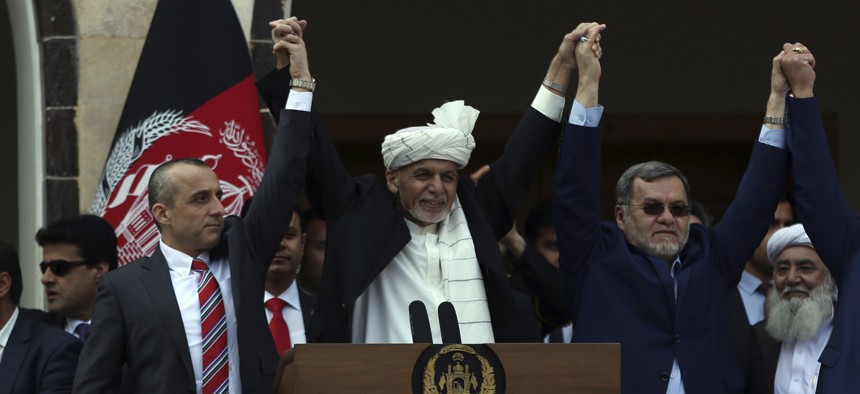
Afghan President Ashraf Ghani, center, second Vice President Sarwar Danish, right, and first Vice President Amrullah Saleh, left, at an inauguration ceremony at the presidential palace in Kabul, Afghanistan, Monday, March 9, 2020. AP Photo/Rahmat Gul
Afghanistan Withdrawal Begins Amid Taliban Attacks on US Allies
Critics say the withdrawal deal puts too much faith in the Taliban.
Related: As Taliban Attack, Esper and Milley Downplay 'Mixed' Results of Peace Deal
Related: The US Once Wanted Peace in Afghanistan
Related: Explainer: The US-Taliban Deal in Afghanistan
The first stage of the U.S. withdrawal from Afghanistan — intended, at least in theory, to be the beginning of the end of 19 years of war — began on Monday, even as the Taliban continued to carry out attacks on U.S.-backed Afghan forces across the country.
“U.S. Forces Afghanistan has begun its conditions-based reduction of forces to 8,600 over 135 days,” spokesman Col. Sonny Leggett said in a statement. “USFOR-A maintains all the military means and authorities to accomplish our objectives—including conducting counterterrorism operations against al-Qaeda and ISIS-K and providing support to the Afghan National Defense and Security Forces.”
The withdrawal, negotiated as part of the deal with the Taliban to end American involvement in the war, has drawn criticism from both sides of the aisle. Democrats and some hawkish Republicans have argued that it puts too much faith in the Taliban to uphold its end of the bargain. The deal calls for a complete U.S. withdrawal within 14 months, contingent on a commitment from the Taliban to prevent “any group or individual, including al-Qaida, from using the soil of Afghanistan to threaten the security of the United States and its allies.”
“This is not a peace agreement. It is a fig leaf for withdrawal and for abandoning our Afghan allies,” Rep. Tom Malinowski, D-N.J., said in a Friday op-ed in the Washington Post.
Sen. Lindsey Graham, R-S.C., a close ally of the president, wants the U.S. to leave a residual force to carry out counterterrorism missions. “I will never support relying on the Taliban to police al Qaeda and ISIS — who are dead-set on attacking American interests throughout the world,” he said on Twitter last week.
The deal, signed Feb. 29 in Doha, envisions talks between the Afghan government and the Taliban, which were slated to begin in Oslo on Tuesday. But political chaos in Kabul and a dispute over a prisoner exchange have put those talks in doubt.
On Monday, President Ashraf Ghani, the winner of the national election in September, and the opposing candidate Abdullah Abdullah, both declared themselves president, after U.S. efforts to resolve the crisis failed. Meantime, Ghani has rejected a prisoner exchange that the Taliban agreed to in the deal, and which was meant to take place before the Oslo talks began.
“These were heavily negotiated documents. All the parties understand that it's time for prisoner exchanges to take place,” Secretary of State Mike Pompeo said Friday.
The Taliban has ratcheted up attacks on Afghan forces since the deal was signed, noting that the seven-day “reduction in violence” period that preceded the signing of the deal has now ended. The Pentagon carried out an airstrike in Helmand province last week, the first in 11 days, to disrupt an attack on an Afghan checkpoint.
“We are committed to peace, however we have the responsibility to defend our #ANDSF partners,” said Leggett in a statement at the time “#Afghans & US have complied w/ our agreements; however, Talibs appear intent on squandering this opp. and ignoring the will of the people for #peace. #Showyourcommitment”
Pentagon leaders insist that the ultimate withdrawal from Afghanistan is “conditions-based.”
Before the start of the withdrawal, there were roughly 13,000 U.S. troops in Afghanistan. Former officials say some 8,600 troops — roughly the number in Afghanistan at the end of the Obama administration — is probably the minimum number needed to continue to carry out counterterrorism missions. Anything less than that, and the United States would start to lose valuable intelligence capabilities across the sprawling nation, they say.
But President Trump, who campaigned on ending the war, has made no secret of his desire to get the United States out of Afghanistan. Although Trump was convinced by defense leaders to send more troops to Afghanistan in the early days of his presidency, the administration came close to clinching a deal with the Taliban last summer. Trump abruptly called off the talks in September after a Taliban attack killed a U.S. soldier.
Joint Chiefs Chairman Gen. Mark Milley, speaking to Senate Armed Services Committee lawmakers on Capitol Hill last week, characterized ongoing Taliban attacks as “small, low-level attacks.”
“The Taliban have signed up to a whole series of conditions,” Milley said Wednesday. “Of significance, there’s no attack on 34 provincial capitals, no attacks in Kabul, no high profile attacks, no suicide bombers, no vehicle-born suicide, no attacks against U.S. forces, no attack against coalition [forces].
“There’s a whole laundry list of these things that aren’t happening,” he said.
